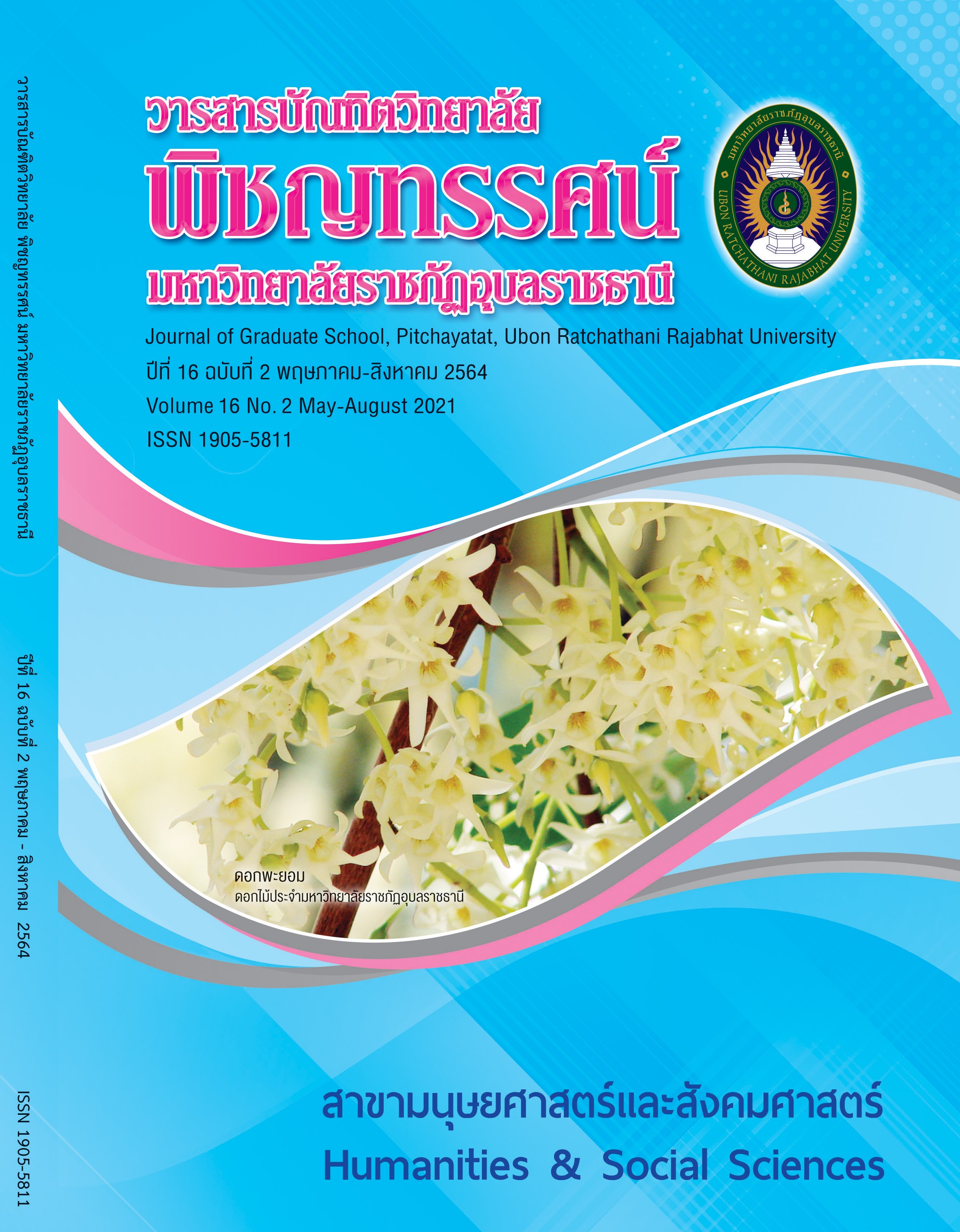สบู่เหลวต้านเชื้อแบคทีเรียจากสารสกัดเปลือกกล้วย
คำสำคัญ:
เปลือกกล้วย, สบู่เหลว, ต้านเชื้อแบคทีเรียบทคัดย่อ
ความต้องการที่เพิ่มขึ้นของตลาดเครื่องสำอางทำให้ผลิตภัณฑ์ทำความสะอาดผิวเช่นสบู่เหลวเกิดนวัตกรรมใหม่ ๆ ทั้งปริมาณ คุณภาพ ประโยชน์ และวัตถุดิบ หนึ่งในนวัตกรรมที่ได้รับการพัฒนาคือการพยายามใช้สารสกัดธรรมชาติจากเปลือกกล้วยเป็นส่วนผสมของสบู่ โดยมีการเพิ่มสารออกฤทธิ์เช่นสารต้านเชื้อแบคทีเรียและอื่น ๆ งานวิจัยนี้มีวัตถุประสงค์ 1) เพื่อสกัดและประเมินความสามารถในการต้านการเจริญเติบโตของเชื้อแบคทีเรีย E. coli และ S. aureus 2) เพื่อพัฒนาสูตรสบู่เหลวที่มีส่วนผสมของสารสกัดจากเปลือกกล้วยน้ำหว้าและ 3) ทดสอบความคงตัวของผลิตภัณฑ์เหลว ผลการวิจัยพบว่า สารสกัดเปลือกกล้วยน้ำหว้าที่สกัดด้วยเอทานอล 95% ความเข้มข้น 2.5 มิลลิกรัมต่อมิลลิลิตร มีความสามารถในการต้านการเจริญเติบโตของเชื้อแบคทีเรียทั้งสองชนิด โดยเชื้อแบคทีเรียทั้งสองชนิดถูกยับยั้งด้วยค่าบริเวณการยับยั้งเท่ากับ 0.8 เซนติเมตรเท่ากัน ค่า MIC ของเชื้อ Escherichia coli เท่ากับ 25 มิลลิกรัมต่อมิลลิลิตร และเชื้อ Staphylococcus aureus เท่ากับ 50 มิลลิกรัมต่อมิลลิลิตร ค่าMBC ที่ยับยั้งเชื้อ Escherichia coli 100 มิลลิกรัมต่อมิลลิลิตร และเชื้อ Staphylococcus aureus เท่ากับ 50 มิลลิกรัมต่อมิลลิลิตร สบู่เหลวที่ถูกพัฒนาสูตรใช้สารสกัดจากเปลือกกล้วยเป็นส่วนผสมในอัตราส่วน 0.25% โดยน้ำหนักต่อน้ำหนัก ซึ่งเป็นอัตราส่วนทำให้เกิดบริเวณยับยั้งและให้สบู่เหลวมีที่เหมาะสมและมีความคงตัวโดยมีค่าพีเอชเท่ากับ 6.43 ความหนืดเท่ากับ 669.8 cp และไม่เกิดการแยกชั้นของเนื้อผลิตภัณฑ์ จากผลการทดลองนี้แสดงให้เห็นว่าสารสกัดจากเปลือกกล้วยมีแนวโน้มที่จะใช้เป็นสารต้านแบคทีเรียในผลิตภัณฑ์เครื่องสำอางได้
References
Akharaiyi, F.C., O.S Asoso and L.S. Animba. “pla Antibacterial Activities of Plantain (Musa paradisiaca) Peel and Fruit,” Scholar research. 8, 5 (2516): 5-11.
Chabuck, Z. A. G., et al. (2013). “Antimicrobial effect of aqueous banana peel extract Iraq,” Research Gate: Pharmaceutical Sciences. 1(2013): 73-75.
Cockerill, F.R. et al. Performance standards for antimicrobial disk susceptibility tests. 11th ed. Pennsylvania USA: Clinical and Laboratory Standards Institute, 2012.
Ehiowemwenguan, G., A.O. Emoghene and J. E. Inetianbor. “Antibacterial and phytochemical analysis of banana fruit peel,” IOSR Journal Of Pharmacy. 4, 8 (August 2014): 18-25.
Emaga, T. H. et al. “Effects of the stage of maturation and varieties on the chemical composition of banana and plantain peels,” Food Chemistry. 103, 2 (September 2006): 590-600.
Fu, X. et al. “Comparative analysis of pigments in red and yellow banana fruit,” Food Chemistry. 239 (2016): 1009–1018.
Joshi, M.G., D.V. Kamat and S.D. Kamat. “Evaluation of herbal handwash formulation,” Natural Products Radiance. 7, 5 (January 2008): 413-415.
Kapadia, S, P. Pudakalkatti and S. Shivanaikar. “Detection of antimicrobial activity of banana peel (Musa paradisiaca L.) on Porphyromonas gingivalis and Aggregatibacter actinomycetemcomitans: An in vitro study,” Contemporary Clinical Dentistry. 6, 4 (October–December 2015): 496-499.
Mokbel, M.S., and F Hashinaga. “Antibacterial and antioxidant activities of banana (Musa, AAA cv. Cavendish) fruit peel,” American Journal of Biochemistry and Biotechnology. 1, 3 (September 2005): 125-131.
Palace V.P. et al. “Antioxidant potentials of vitamin A and carotenoids and their relevance to heart disease.” Free Radic. Biol. Med. 26, (5-6) (March 1999): 746–761.
Proksch, E. “pH in nature, humans and skin,” The Journal of Dermatology. 45, 9(2018): 1-9.
Sidhu, Jiwan s. and Tasleem A. Zafar. “Bioactive compounds in banana fruits and their health benefits,” Food Quality and Safety. 2 (August 2018): 183–188.
Subramaniam, Y., et al. “Antimicrobial activity of Musa acuminate peel extract against gram-positive bacteria,” International Journal of Life Sciences and Biotechnology. 3(2), 191-196. DOI: 10.38001/ijlsb.747883
Sulaiman, S. F. et al. “Correlation between total phenolic and mineral contents with antioxidant activity of eight Malaysian bananas (Musa sp.),” Journal of Food Composition and Analysis. 24, 1 (February 2011): 1-10.
Downloads
เผยแพร่แล้ว
How to Cite
ฉบับ
บท
License
บทความทุกเรื่องได้รับการตรวจความถูกต้องทางวิชาการโดยผู้ทรงคุณวุฒิภายนอกอย่างน้อย 2 คน ความคิดเห็นในวารสารบัณฑิตวิทยาลัย พิชญทรรศน์ มหาวิทยาลัยราชภัฏอุบลราชธานี เป็นความคิดเห็นของผู้เขียนมิใช่ความคิดเห็นของผู้จัดทำ จึงมิใช่ ความรับผิดชอบของบัณฑิตวิทยาลัย มหาวิทยาลัยราชภัฏอุบลราชธานี และบทความในวารสารบัณฑิตวิทยาลัย พิชญทรรศน์ มหาวิทยาลัยราชภัฏอุบลราชธานี สงวนสิทธิ์ตามกฎหมายไทย การจะนำไปเผยแพร่ต้องได้รับอนุญาตเป็นลายลักษณ์อักษรจากกองบรรณาธิการ





